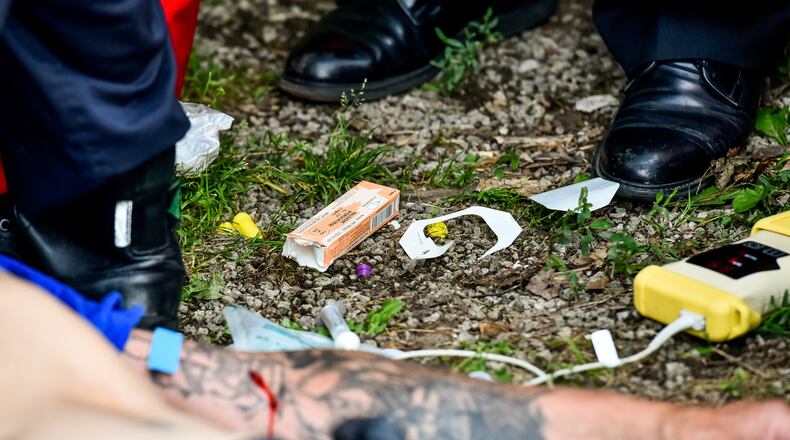Naloxone is a medication used to reverse an overdose caused by an opioid drug, such as prescription pain medications or heroin.
“I believe we are beyond the first step in our community, to revive people. We are beyond getting enough Narcan. Lots of communities are at that point,” Troy Fire Chief Matt Simmons said. “We are at the point of saying, OK, how do we get people off (opioids), to look at the deeper issues of why are they addicted in first place.”
RELATED: Miami County heroin coalition launched to help fight addiction
Thom Grim, director of the Miami County Recovery Council, said the organization has been dealing with heroin problems for the past eight years, seeing an “explosion” the last three years.
Central to the effort, Simmons and Grim said, is a Quick Response Team formed in summer 2016 by the city of Troy and active in reaching out to those who have overdosed since October. Team members include a MCRC outreach specialist, a police officer and a firefighter/paramedic who attempt to visit with those who survive an overdose within days of the incident.
›› DOWNLOAD OUR MOBILE APPS FOR LATEST BREAKING NEWS
“These victims cannot believe that we are coming out there, the cold call. With the families, when we come, there are tears, some form of relief that someone is trying to help,” Simmons said. “They see police here not to arrest me, but to help me. It is a different component when you say, ‘You about died, what can we do because to stay on this track, you will die.’”
The team has made 91 initial visits and more than 200 visits total including return stops since the program started. Another QRT program is kicking off in early July in Piqua, Bruce Jamison, Piqua’s police chief said.
A countywide Heroin Coalition formed in early 2016 held a countywide Hope Over Heroin event in July 2016 at the county fairgrounds. It has put into place several programs including a men’s Hope House providing short term stays for social detoxification in Troy. Work is under way on a similar facility for women.
Of the 20 men who have been admitted to Hope House, 12 have graduated, six left against staff advice and two were asked to leave, Grim said.
Those efforts to provide added treatment and services have included the Tri-County Board of Recovery and Mental Health Services that has initiated new programs in Miami, Darke and Shelby counties, said Mark McDaniel, the Tri-County board executive director.
The Tri-County board’s latest strategic plan includes a system ranging from prevention efforts to inpatient treatment, he said. In-between are programs emphasizing more and longer support type services and added use of peer specialists - those who have been there but “have a sustained recovery and can communicate well,” McDaniel said.
“When we look at what we have in place, what we are working on, it sounds crazy to be optimistic, but I feel we definitely are moving in the right direction,” Grim said,
Miami County recorded 25 deaths attributed to overdoses through the end of June, exceeding the 20 overdose deaths recorded for all of 2016, county Coroner Dr. William Ginn said. The overdose deaths have involved fentanyl, heroin, carfentanil, cocaine, alcohol, other narcotics and other drugs, according to Ginn. “The vast majority of toxicology screens show multiple drugs,” he said.
Despite optimism, Simmons said there is no denying the impact of heroin and other opioids is widespread. “It is everywhere,” he said.
Jennifer Sanders, director of the Miami County Court Appointed Special Advocate/Guardian Ad Litem program, said the impact of the epidemic is being felt by the agency and volunteer child advocates. In 2016, 30 percent of new cases of abused and neglected children had one or more parent addicted to heroin. So far this year, the number is almost 50 percent. Last year, the agency served 152 children. So far this year, there are 137 children served by a CASA/GAL advocate.
“Our volunteers and staff have stepped up to ensure that we are able to continue serving 100 percent of the abused and neglected children referred to our program by Miami County Juvenile Court. However, as our numbers quickly grow, it is becoming more of a challenge,” Sanders said.
Miami County Public Health in May began giving out Narcan kits to those who attend a training on Tuesdays at noon at the health department.
Health Commissioner Dennis Propes and Jordan Phillips, the health district injury prevention coordinator who teaches the education program, said the initial response to the classes at the health department has been slow but more people attend group presentations such as the local Families of Addicts group.
Propes also is the new facilitator for the Heroin Coalition. He said he thinks the coalition has had successes because territorial issues have been set aside. “As a community, we are working very well together. I hear from other counties where it is ‘This is our job, that is your job, stay out of what we are trying to do,’” Propes said. “Here we don’t get that. It is ‘What can we do to help?’ There is tremendous amount of cooperation.”
Contact this contributing writer at nancykburr@aol.com
About the Author
